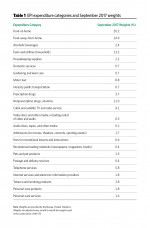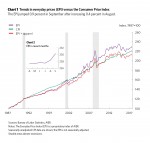Everyday Prices Jump as Familiar Themes Reappear
AIER’s Everyday Price Index jumped 0.9 percent in September, ahead of the 0.5 percent gain in the Consumer Price Index. The EPI measures price changes people see in everyday purchases such as groceries, restaurant meals, gasoline, and utilities. The EPI is not seasonally adjusted, so we compare it with the unadjusted CPI. The EPI including apparel, a broader measure, gained 1.0 percent in September as apparel prices rose 0.2 percent for the month. Both measures exclude prices of infrequently purchased, big-ticket items (such as cars, appliances, and furniture) and prices contractually fixed for prolonged periods (such as housing).
Over the past 12 months, the EPI has risen 2.4 percent while the EPI including apparel is up 2.1 percent. The more widely known price gauge, the Consumer Price Index, reported by the Bureau of Labor Statistics, includes fewer frequently purchased items and everyday purchases. That measure is up 2.2 percent over the past 12 months. Over the last five years, the EPI is unchanged, showing no price increase compared to an average annual rise of 1.3 percent for the CPI.
Familiar themes are reappearing within the components of the EPI. Energy prices tend to be volatile and are a major component of the EPI. Therefore, energy-price moves often drive short-term movements in the overall EPI. Motor fuels jumped 10.6 percent in September on a not seasonally adjusted basis. That surge more than accounted for the entire rise in the overall EPI. Excluding motor fuels, the EPI was down 0.1 percent for the month. Among the components of the EPI, 13 of the 24 categories were up in September while 10 were down and 1 was unchanged.
Over the past year, about two-thirds of the categories show higher prices while one-third show price declines. A similar proportion show five-year annualized price gains and declines. The categories showing five-year declines include housekeeping supplies, nonprescription drugs, video and audio services, pets and pet products, telephone services, internet services, personal-care products, and motor fuels. Furthermore, food for home consumption is up just 0.6 percent at an annual rate over the past five years while apparel prices are down 0.1 percent over the same period.
Among the components with the largest weights in the EPI, food at home (20.2 percent weight) is up 0.4 percent from a year ago and up at a 0.6 percent annualized rate over the past five years; food away from home (14.9 percent) is up 2.4 percent over both the last 12 months and the last five years; household fuels and utilities (13.2 percent) are up 2.8 percent for the year and 1.6 percent over five years; nonprescription drugs (11.0 percent) are off 0.6 percent over the last 12 months and 0.6 percent annualized over five years; and motor fuel (8.8 percent) is up 19.2 percent since last September but is down 6.9 percent annually since 2012. Combined, they account for 67.2 percent of the EPI.
The key take-away is that broad-based increases are still not present in everyday prices. Some areas are seeing outright price declines, many are seeing modest price increases, and a few are experiencing persistent, sizable increases.







